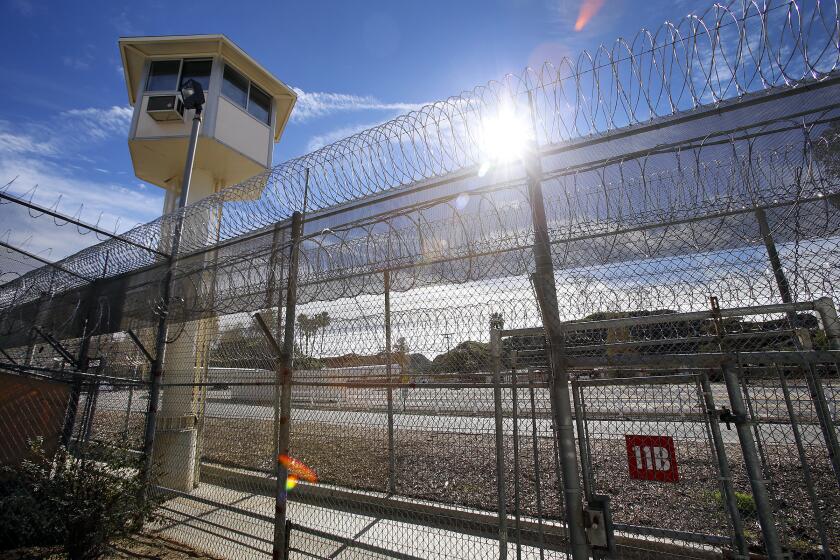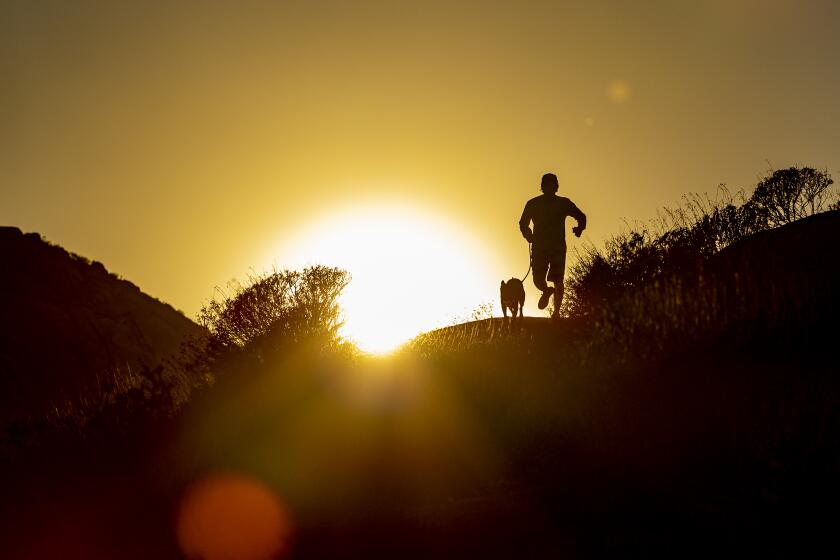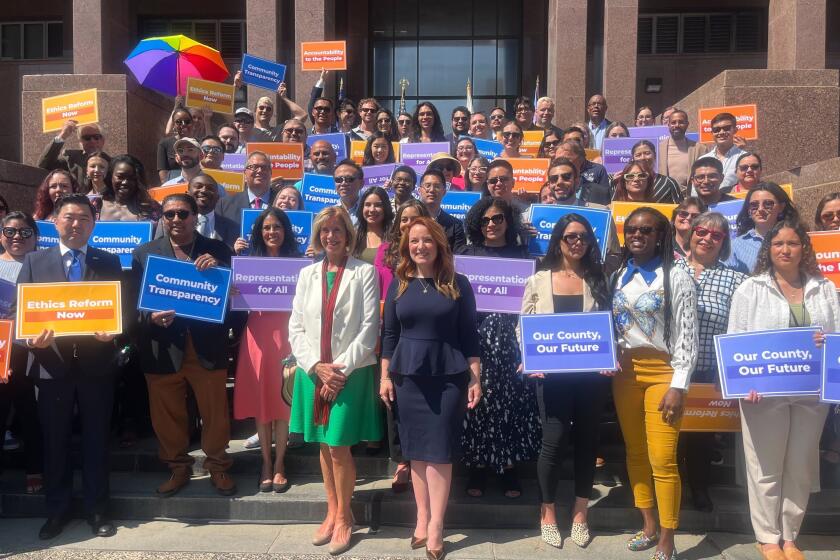Officer-Involved Shootings at 10-Year High : LAPD: Rise in 1992 is blamed on spring riots, when nine people were shot by police. But subtracting those cases, number is still higher than other U.S. cities, critics of the department say.
- Share via
In a year when the Los Angeles Police Department hired a new chief and began trading its paramilitary image for a more sensitive, community-based approach to fighting crime, the number of people shot by officers in 1992 hit a 10-year high.
Contributing significantly to the total were the shootings of nine people during the spring riots--the worst civil disturbances in the United States this century. In all, 25 people were killed and 52 injured in officer-involved shootings last year.
The 1992 tally was marked by several controversial incidents, including the fatal shooting of an unarmed 36-year-old tow truck driver by a motorcycle officer in South-Central, and the killing of an 18-year-old Pacoima gang member wielding a broomstick, who was shot nine times.
These events have complicated the task of Police Chief Willie L. Williams, who has vowed to “build public confidence” in the troubled department by increasing citizen involvement in reshaping its policies.
The department’s use of force policy was reviewed by the Christopher Commission in its wide-ranging investigation after the videotaped beating of Rodney G. King by officers in 1991. In calling for an overhaul of the department, the commission recommended the use of community-based policing with more emphasis on restraint and prevention than physical force.
“The riots and the aftermath make the last year an anomaly in some respects,” said Gilbert T. Ray, executive director of the Christopher Commission.
Indeed, last year’s tally would be unexceptional if shootings during the riot period were subtracted. Excluding the nine shot then, 68 people were shot by police in 1992. Sixty-one were shot in 1991; 69 in 1990; 68 in 1989; 61 in 1988, and 56 in 1987.
“Crime remains a major problem and the Police Department is understaffed for the size of the population and the geographical area it has to cover,” Ray said. “Still, I’m encouraged by the steps I have seen lately.”
But some longtime critics doubt that the new chief will be able to change the department’s approach to shootings, and they cite the recent numbers to bolster that contention.
“The LAPD will continue to be the brutal machine that (former chiefs) Ed Davis and Daryl Gates made it,” said Stephen Yagman, a civil rights attorney who specializes in police abuse cases. “Leopards don’t change their spots unless someone pours Clorox on them.”
Police contend that shootings have gone up in response to the dangers that officers face on the street--where the weapons are becoming more sophisticated and the violence more random and brutal. Six police officers were shot in 1992, including one fatally, authorities said.
“It’s amazing to me that we don’t shoot more people,” said Lt. William Hall, who heads the LAPD unit charged with investigating officer-involved shootings. “If you go out on the streets and listen some nights, invariably you hear gunfire, and usually it’s automatic gunfire. These are not guns in the home for protection. . . . Officers must have blinders to not get involved in more shootings than we do.”
Still, the Los Angeles Police Department, for the size of the force, tends to shoot more people than its counterparts in other large cities. That--in addition to complaints about individual shooting cases--gives rise to much of the criticism.
Last year, for example, Los Angeles police shot an average of about 10 people per 1,000 officers. The Philadelphia Police Department, which Williams formerly led, averaged about seven such shootings per 1,000 officers. In New York, the difference was greater: police there shot about three people for every 1,000 officers.
The difference between New York and Los Angeles has been attributed to “a more aggressive style of policing” here, said James Fyfe, a professor of criminal justice at Temple University.
“Historically, there has been a much greater laxity about enforcing the rules of deadly force in Los Angeles,” said Fyfe, a former New York City policeman. “One way to compare the different approaches is to look at the elite units in the two departments. In New York City the elite unit is the hostage negotiating team, while in Los Angeles it’s the SWAT team. Different approaches to the same kind of problem. One defines success in terms of waiting it out--an absence of bloodshed. The other says, ‘Let’s get it over with.’ ”
The tone for a department is set by the top brass, Fyfe said. If superiors decree that firearms are only to be used as a last resort, officers in the field will get the message, he said, adding that officers need better training in responding to specific situations.
Just recently, Williams found the July police shooting of tow truck driver John Daniels Jr. to be unjustified; the officer faces an internal hearing on the matter. The department has not completed its investigation into the November shooting death of Efrin Santos Lopez, 18, who was shot when he charged an officer while wildly swinging a broomstick.
The two shootings prompted the American Civil Liberties Union and several other community groups to ask the department to rewrite its officer-involved shooting policy, beginning with a historical review dating back to the 1979 shooting of Eulia Love. Her death sparked a community uproar that was not exceeded until the King beating.
“Some longstanding and serious concerns have been rekindled about the tradition of the LAPD to be trigger-happy,” said Allan Parachini, public affairs director for the American Civil Liberties Union of Southern California.
Parachini applauded Williams’ decision on the Daniels shooting but questioned the delay in reaching a conclusion on the Lopez case.
Ultimately, he said, it may take time and training from the department to change.
“It’s a long process and we have to have patience,” he said. “But if the decision in the Daniels case is a signal that the department is changing its approach, we want to encourage that.”
Police Commission President Jesse Brewer said the department is in the midst of revamping many of its long-held policies. “We have to accept the fact that we live in a violent society and that there are people who are more willing to challenge the police now than ever before,” he said.
But at the same time, he added, the department is committed to change.
“This is a long-range process. Things don’t happen overnight,” he said. “But the message that the chief is sending out is very clear. He is not going to tolerate misconduct and inappropriate use of force. That philosophy has been preached since the chief has been in place. It starts at the top and goes down.”
Officer-Involved Shootings Seventy-seven people were killed or injured in Los Angeles Police Department shootings in 1992--the highest total in a decade. 1992
Deaths: 25
Injuries: 52
1991
Deaths: 23
Injuries: 38
1990
Deaths: 37
Injuries: 32
1989
Deaths: 22
Injuries: 46
1988
Deaths: 23
Injuries: 38
1987
Deaths: 22
Injuries: 34
1986
Deaths: 21
Injuries: 27
1985
Deaths: 23
Injuries: 42
1984
Deaths: 19
Injuries: 27
1983
Deaths: 25
Injuries: 40
1982
Deaths: 21
Injuries: 31
Source: Los Angeles Police Department
More to Read
Sign up for Essential California
The most important California stories and recommendations in your inbox every morning.
You may occasionally receive promotional content from the Los Angeles Times.













